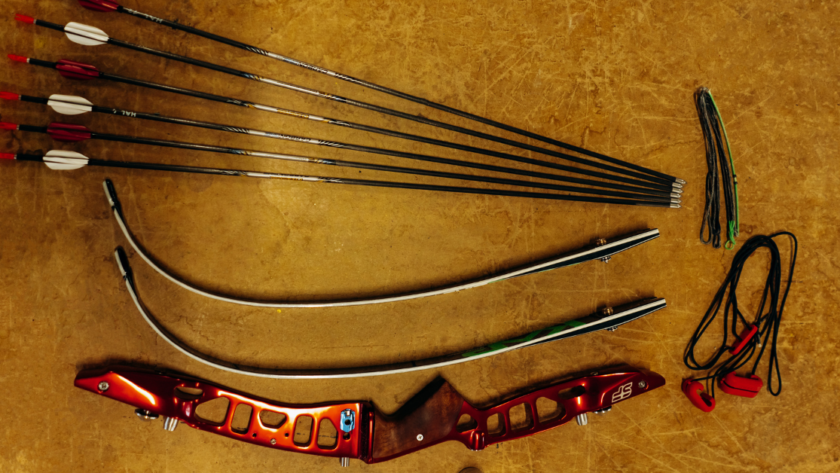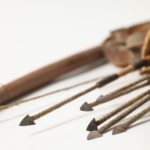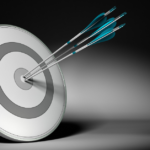As an avid archer with years of experience, I’ve learned that proper care and maintenance of your archery equipment is absolutely crucial.
Whether you’re a competitive target shooter or a passionate bowhunter, keeping your gear in top condition will dramatically improve your performance and extend the life of your equipment.
In this detailed guide, I’ll share everything I’ve learned about maintaining bows and arrows, from basic cleaning techniques to advanced tuning methods.
Just a heads-up: This post contains affiliate links, which means if you click and make a purchase, I may earn a small commission—at no extra cost to you. I only recommend products that I trust and believe will help archers keep their gear in top shape. Now, let’s get into how to properly maintain your bow and arrows!
Understanding Your Archery Equipment
Before diving into maintenance procedures, it’s essential to have a solid grasp of the components that make up your archery setup. This knowledge forms the foundation for effective care and troubleshooting.
Anatomy of a Bow
Regardless of whether you use a traditional longbow, recurve, or modern compound bow, certain elements stay consistent:
- Limbs: The flexible arms of the bow that store and release energy
- Riser: The central part of the bow that you grip
- String: The cord that connects the limb tips and propels the arrow
- Nocking point: The location on the string where the arrow is placed
- Arrow rest: The device that supports the arrow during draw and release
Compound bows have extra components:
- Cams: Wheel-like mechanisms at the limb tips that provide a mechanical advantage
- Cables: Work in conjunction with the cams to store and release energy
- Cable guard: Keeps the cables away from the arrow’s path
Arrow Components
Understanding the parts of an arrow is equally important:
- Shaft: The main body of the arrow
- Fletching: The vanes or feathers at the rear of the arrow that stabilize flight
- Nock: The notch at the rear of the arrow that clips onto the bowstring
- Point: The tip of the arrow, which can be a practice point, field point, or broadhead
Basic Bow Maintenance
Regular maintenance of your bow is critical for consistent performance and safety. Here’s a step-by-step guide to keeping your bow in prime condition:
1. Visual Inspection
Before each shooting session, carefully examine your bow:
- Check the limbs for any signs of cracks, twists, or delamination
- Inspect the riser for any loose screws or signs of damage
- Examine the string and cables (if applicable) for fraying or wear
2. String Care
A well-maintained bowstring is crucial for accuracy and power transfer:
- Wax your string regularly to protect it from moisture and reduce friction
- Apply a thin layer of bow wax, working it into the strands with your fingers
- Be careful not to over-wax, as this can attract dirt and debris
- Replace the string when it shows significant wear or every 1-2 years for frequent shooters
3. Cam and Cable Maintenance (Compound Bows)
For compound bow users, the cam system requires special attention:
- Ensure the cams are properly aligned
- Lubricate the axles with a drop of high-quality bow lubricant
- Check for any unusual wear on the cam surfaces
- Inspect cables for fraying or serving separation
4. Bow Storage
Proper storage prevents damage and maintains your bow’s performance:
- Store your bow in a cool, dry place away from direct sunlight
- Use a bow case for transportation and storage
- Never store your bow in a hot car or damp environment
- For compound bows, slightly relax the limbs by backing off the limb bolts a few turns
5. Cleaning
Regular cleaning prevents buildup of dirt and grime that can affect performance:
- Use a soft, dry cloth to wipe down all surfaces of the bow
- For stubborn dirt, use a slightly damp cloth, then dry thoroughly
- Clean the arrow rest and sight, ensuring moving parts are free of debris
- Avoid using harsh chemicals or solvents that could damage bow finishes
Arrow Maintenance and Care
Arrows are often overlooked in maintenance routines, but they’re just as crucial as the bow itself. Here’s how to keep your arrows in top shape:
1. Straightness Check
Even slightly bent arrows can significantly impact accuracy:
- Use an arrow spinner or roll each arrow on a flat surface to check for wobble
- Replace arrows that show noticeable bends or curves
2. Fletching Inspection
Damaged fletching affects arrow flight and accuracy:
- Check each fletching for tears, looseness, or missing pieces
- Re-fletch arrows with damaged vanes or replace them entirely
- Ensure fletching is securely attached and properly aligned
3. Nock Examination
A damaged nock can lead to inconsistent arrow release and potential injury:
- Inspect nocks for cracks or chips
- Ensure nocks are properly aligned with the fletching
- Replace any damaged or suspicious nocks immediately
4. Shaft Cleaning
Clean arrow shafts improve accuracy and extend arrow life:
- Wipe down shafts with a clean, dry cloth after each use
- For stubborn dirt, use a mild soap solution, then dry thoroughly
- Avoid using harsh chemicals that could damage the shaft material
5. Point and Insert Care
For both target points and broadheads:
- Check that points and inserts are securely attached to the shaft
- For broadheads, maintain sharpness and check for any damage to the blades
- Clean and dry broadheads after each use to prevent rust
Advanced Tuning Techniques
Once you’ve mastered basic maintenance, exploring advanced tuning techniques can help you squeeze every ounce of performance out of your equipment.
Paper Tuning
Paper tuning diagnoses and fixes arrow flight issues:
- Set up a frame with a sheet of paper
- Shoot an arrow through the paper at close range (5-7 yards)
- Analyze the tear pattern:
- A perfect tune shows a clean, round hole
- Vertical tears indicate nocking point issues
- Horizontal tears suggest rest alignment problems
- Make small adjustments to your setup based on the tear pattern
- Repeat the process until you achieve a clean hole
Walk-Back Tuning
This method helps fine-tune your centershot and sight windage:
- Set up a vertical line target at 20 yards
- Shoot one arrow at 20 yards, aiming at the top of the line
- Move back to 30 yards and shoot another arrow at the same aiming point
- Repeat at 40 and 50 yards
- Analyze the arrow pattern:
- Arrows should form a vertical line down the target
- If arrows trend left or right, adjust your rest or sight accordingly
Bare Shaft Tuning
Shooting unfletched arrows alongside fletched ones can reveal subtle tuning issues:
- Shoot a group of fletched arrows at 20 yards
- Shoot several unfletched arrows at the same target
- Compare the impact points:
- Bare shafts grouping with fletched arrows indicate good tune
- Left or right impacts suggest spine issues or rest misalignment
- High or low impacts indicate nocking point problems
Bow Press Usage (Compound Bows)
A bow press allows for advanced adjustments on compound bows:
- Safely compress the limbs to work on strings, cables, and cams
- Adjust cam timing for optimal performance
- Replace strings and cables
- Fine-tune draw length and weight
Caution: If you’re not confident in your abilities, leave these adjustments to a professional bow technician.
Maintenance for Different Archery Disciplines
Your maintenance routine should adapt to your specific archery discipline:
Target Archery
Target archers focus on consistency and precision:
- Pay extra attention to arrow spine consistency
- Regularly check and adjust sight settings
- Maintain a consistent draw length and anchor point
Bowhunting
Bowhunters need equipment that can withstand harsh conditions:
- Use weatherproof string wax and lubricants
- Regularly check broadhead sharpness and alignment
- Ensure all equipment is quiet and free from rattles
Traditional Archery
Traditional archers using wooden bows have unique considerations:
- Apply a light coat of bow finish or wax to protect wood from moisture
- Pay extra attention to string alignment on the limb tips
- Regularly check for limb twists or changes in tiller
3D Archery
3D archers face challenges with varied shooting conditions:
- Use durable arrow vanes that can withstand impacts with targets
- Regularly check arrow straightness, as impacts can bend shafts
- Maintain consistent arrow weight for varied distance shooting
Common Maintenance Pitfalls to Avoid
Even experienced archers can fall into these maintenance traps:
Overwaxing the Bowstring
Excessive wax attracts dirt and causes premature wear. Apply wax sparingly and work it into the string fibers thoroughly.
Neglecting Arrow Spine
Using arrows with incorrect spine for your bow leads to accuracy issues and potential equipment damage. Consult a spine chart or professional to ensure proper arrow selection.
Improper Storage
Storing your bow in extreme temperatures or high humidity causes warping and damage. Always store in a cool, dry place and use a quality bow case.
Dry Firing
Never release the bowstring without an arrow nocked. This can cause severe damage to your bow and potentially injure you.
Overtightening Bolts
Excessive force when tightening bolts can strip threads or damage components. Use the proper tools and follow manufacturer torque specifications.
Ignoring Small Issues
Minor problems can quickly become major ones. Address any unusual noises, feelings, or performance changes promptly.
Creating a Maintenance Schedule
Developing a regular maintenance routine keeps your equipment in top shape:
Daily (After Each Use)
- Wipe down bow and arrows
- Inspect for any obvious damage or wear
- Store properly in a cool, dry place
Weekly
- Apply string wax
- Check all screws and bolts for tightness
- Inspect arrow fletching and nocks
Monthly
- Perform a thorough cleaning of all equipment
- Check bow timing and synchronization (compound bows)
- Conduct a paper tuning test
Seasonally
- Replace string and cables if needed
- Check limb alignment and tiller
- Perform a finish tune-up, including walk-back and bare shaft tuning
Annually
- Have a professional bow technician perform a comprehensive inspection
- Replace any worn components
- Update any outdated equipment
Tools for Effective Maintenance
Having the right tools makes maintenance easier and more effective:
- Bow press (for compound bows)
- Arrow spinner
- Bow square
- Allen wrench set
- Serving tool
- Nock pliers
- String wax
- Bow lubricant
- Cleaning cloths
- Arrow fletching jig
Practical Exercises to Hone Your Maintenance Skills
To reinforce your maintenance knowledge, try these exercises:
- Conduct a full equipment inspection, documenting any issues you find
- Practice paper tuning and make necessary adjustments
- Experiment with different types of bow wax to find what works best for your setup
- Learn to tie a bow string and practice on an old string
- Set up a maintenance schedule and stick to it for a month, noting any improvements in your shooting
Frequently Asked Questions
How often should I wax my bowstring?
Wax your bowstring every 2-3 weeks for regular shooters, or whenever the string starts to look dry or fuzzy.
Can I use household lubricants on my bow?
No, avoid using household lubricants. They can damage bow components.
Use only lubricants specifically designed for archery equipment.
How do I know when it’s time to replace my arrows?
Replace arrows if they’re visibly bent, have damaged fletching that can’t be repaired, or if the nocks are cracked or loose.
Is it necessary to unstring a recurve bow after each use?
It’s not necessary for modern recurve bows, but it can extend the life of the limbs. Follow the manufacturer’s recommendations.
How often should compound bow strings be replaced?
Replace compound bow strings every 2-3 years for regular shooters, or sooner if you notice significant wear or fraying.
Can temperature changes affect my bow’s performance?
Yes, extreme temperatures can affect string tension and limb performance. Always allow your bow to acclimate to ambient temperature before shooting.
What’s the best way to transport a bow?
Use a hard bow case for the best protection during transport. Ensure all accessories are secure and the bow is not under tension.
How do I maintain my bow sight?
Regularly check sight pins for tightness, clean lenses with a microfiber cloth, and protect the sight with a cover when not in use.
Is it safe to dry fire a bow with a practice release aid?
No, dry firing a bow, even with a practice release aid, can cause damage. Always use a proper draw check device designed for this purpose.
How do I know if my arrow rest needs replacement?
Replace your arrow rest if you notice excessive wear on the contact points, if it’s not holding the arrow securely, or if you’re experiencing unexplained accuracy issues.
Key Takeaways
- Regular inspection and maintenance are crucial for optimal performance and safety
- Proper string care, including regular waxing, extends the life of your bow
- Arrow maintenance is just as important as bow care for accuracy and consistency
- Advanced tuning techniques like paper tuning can significantly improve your setup’s performance
- Adapt your maintenance routine to your specific archery discipline and equipment type
- Develop a consistent maintenance schedule to keep your equipment in top condition
- Invest in quality maintenance tools to make care easier and more effective
- Address small issues promptly to prevent larger problems
- Seek professional help for complex adjustments or if you’re unsure about any maintenance task



